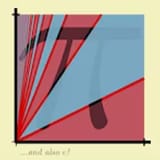Anonymous
6/30/2025, 3:09:22 PM No.16711083
Assume there is a square in a graph. The verticies of this square are located at (0,0), (0,1), (1,0), (1,1). Now, we draw a line y=x to split the square in half. Below the line is colored in red. Above it is colored in blue. Now we draw a line y=2x. Above the line is colored in red. Now we draw a line y=4x. Above the line is colored in blue. Continue alternating this by generating lines of y=x*2^n where n is a nonnegative integer. What is the area of the square that's covered in blue?
Bonus. Let's repeat this but we also allow n to be a nonnegative integer. This means that when you draw slope y=x/2 we color everything below the slope blue, and when we draw y=x/4 we color everything below the slope red. What's the total area the blue portion of the square?
Bonus. Let's repeat this but we also allow n to be a nonnegative integer. This means that when you draw slope y=x/2 we color everything below the slope blue, and when we draw y=x/4 we color everything below the slope red. What's the total area the blue portion of the square?
Replies:
